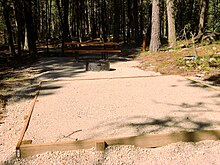
A tent pad is a designated area at a campground site to a set up a tent. It eliminates the need to find a suitable spot to pitch a tent.
Often, a tent pad is a single row of timbers forming a square that retains the fill, resembling a sandbox. In addition to wood, it can also be framed with cement or other material. The framing allows the tent pad to be even and level on rough or sloping terrain and allows for more comfortable sleeping. Some tent pads do not have framing, but instead are raised area of dirt that are sometimes topped with wood chips. An open grassy area does not constitute a tent pad.
Furthermore, a tent pad is often elevated about 4 to 6 inches. This elevation also prevents standing water from developing and reduces the risk of flooding when it rains since it has better drainage.
The tent pad also makes it easier to stake a tent since there are no large rocks or tree roots in the fill. The fill can be composed of sandy soil, dirt, gravel, sand and gravel mix, mulch, cement, or river rock.
Tent pads can come in a variety of sizes depending on the type of camping (e.g. backpacking, leisure camping) or region of the country. There are no standard dimensions, but commons sizes include 8 feet x 8 feet, 10 feet x 10 feet, 12 feet x 12 feet, and 15 feet x 15 feet. Some are oversized, greater than 15 square feet, designed to accommodate a large family tent.
A campsite may have a designated tent pad, but otherwise a flat, durable surface like dirt or gravel would be a suitable alternative. Having a designated tent pad can help prevent damage to the vegetation of the area from staking or setting up the tents in other areas of the campsite.
Tent pads are most often found at developed campgrounds but can also be found in primitive and even wilderness campsites.
Tent pads need to be maintained, otherwise erosion can occur and cause slopes and/or water channels to form.
References
- ^ "Tent Pads And Tent Camping - Campetent". Tent Camping at Campetent. Retrieved 2021-05-23.
- ^ Dow, F.; Dow, S. (2009). U.S. National Forest Campground Guide, Pacific Northwest Region - Oregon. Moon Canyon Publishing, LLC. p. 497. ISBN 978-0-9767516-7-0. Retrieved 2021-05-23.
- ^ "KOA Camping Blog". The Ultimate Guide to Camping Terminology: Camping Terms You Should Know. Retrieved 2021-05-23.
- ^ Douglass, F.M. (2012). The Tent Camper's Handbook. iUniverse. p. 340. ISBN 978-1-4759-3509-7. Retrieved 2021-05-23.